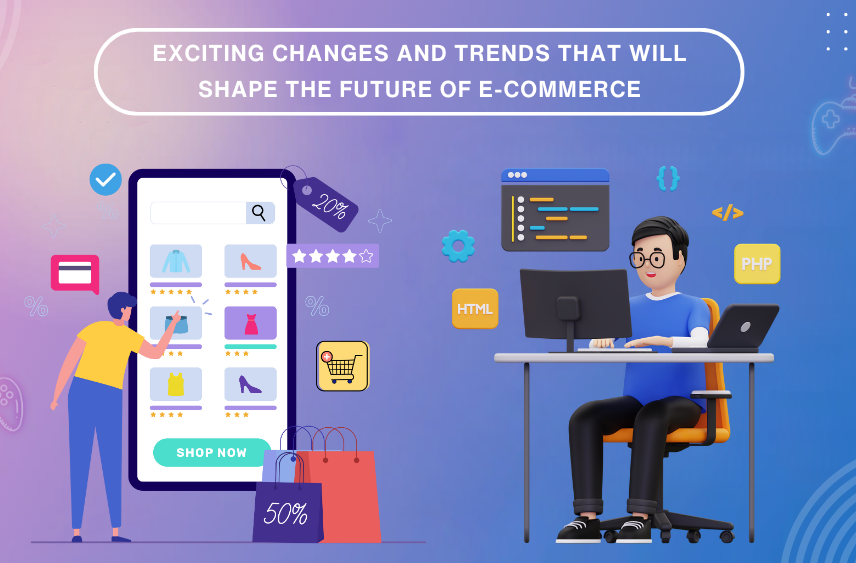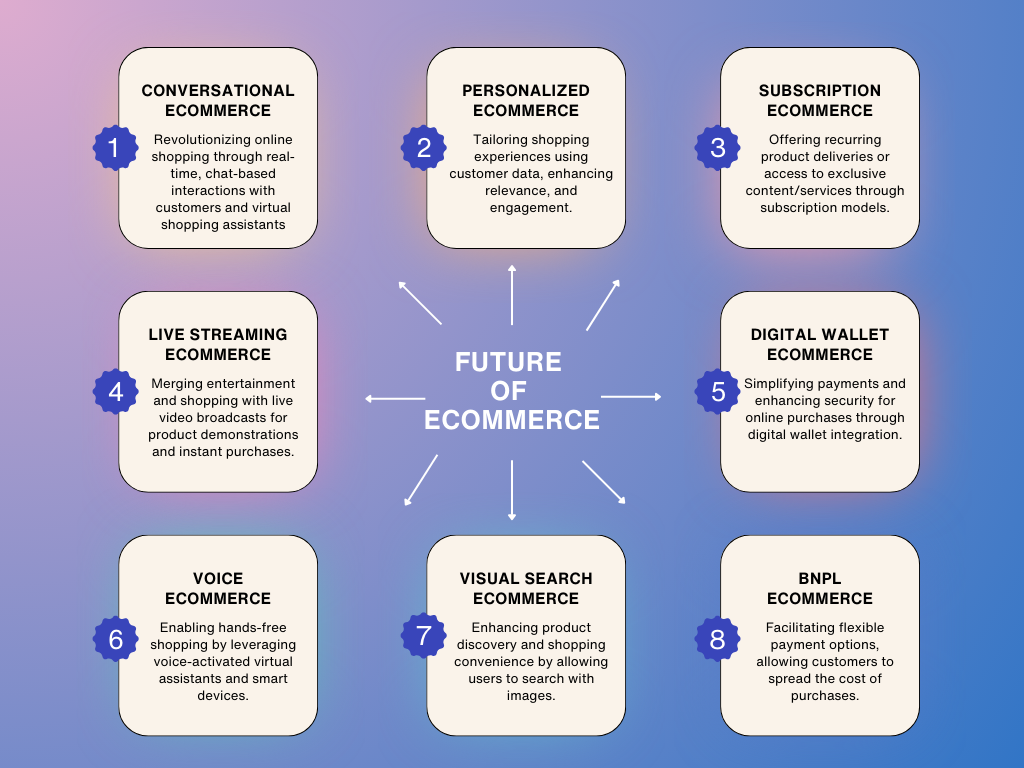
Exciting Changes and Trends That Will Shape the Future of E-commerce
E-commerce is evolving at a rapid rate and you will see some remarkable changes in it in the near future. Several new ways such as conversational ecommerce, live streaming ecommerce, voice ecommerce, etc., are ready to change the whole scenario of online shopping.
In this blog, we are going to discuss the happenings that are shaping the future of ecommerce. We will also try to understand the changes we might see in the near future. So, without wasting time let’s get started.
Current Stage Of Ecommerce
Ecommerce is not at the same stage it was a few years back as countless newcomers are now in the field and their number is increasing with each passing day. Now, the game is getting more competitive and challenging. There are a lot of copycats also knocking off other’s business. In this scenario, you have to make enormous efforts to set yourself apart from this intense competition.
For that reason, people are trying new creative ways to beat the competition and doing experiments to catch the burning opportunities. These efforts are making unprecedented changes in the ecommerce industry leading to an entirely new phase called ecommerce 3.0, where challenges in the industry are not as easy as they once were.
To hold the reins you have to put some extra effort into building relationships with customers. We know that relationships can beat tactics, algorithms, and fancy tricks, so without getting into the time and money-consuming practices you (as an ecommerce professional) should try to build positive relations with customers. You have to level up the ways you demonstrate your products to customers. Videos are the king nowadays to show the benefits and usefulness of the product you want to sell to customers.
So, instead of using tactics, product demonstration and building positive relations with customers are playing a pivotal role in your ecommerce success. By keeping these two things in mind you can understand the direction of emerging trends in ecommerce that we are going to discuss later, in the blog.
Emerging Trends In Ecommerce
Nowadays, third-party eCommerce stores (that are using Amazon-like platforms to sell their products) are paying attention to creating more content around the usefulness of the product they are selling online. After spending years in the industry they got to know that demonstration is getting more and more necessary in the current times. So, content creation is evolving as a new trend in the industry.
- Percentage of Third-Party Sellers:
Another trend emerging in the sector is the increasing percentage of third-party wholesalers. Amazon, which holds 65% of shares in the ecommerce industry as a whole, is seeing a rapid change in the percentage of third-party wholesalers on its platform, which has increased from 53 to 56 percent in a single quarter.
Since Amazon is going to be a more and more rewarding eCommerce platform for third-party wholesalers, their percentage may keep increasing in upcoming years.
- Walmart & Other Platforms:
Although, Amazon is the apple of third-party wholesalers’ eye, its constant 15% charge on every sale made on its platform without considering if sellers are earning a penny or not, sometimes compels wholesalers to look for other alternatives. Even so, despite several platforms working in the ecommerce field, none of them is capable of beating Amazon.
Walmart, anyhow, has the potential to stand in front of Amazon but its business process, logistics, and heavy terms and conditions are a nightmare for third-party wholesalers, making them keep running with Amazon and proving Walmart something like a ‘slow elephant’ in the ecommerce industry.
- Content Requirement and ROI:
Due to plenty of options in front of them and increasing numbers of online frauds, customers are puzzled and more alert than before. Now they want to verify everything about the product before buying it. So, demonstrative and explanatory content became more necessary than ever.
On the other side, due to intense competition enormous efforts and investment are required to get higher returns on investments. WIFM (What’s in it for me) has emerged as a prime aspect to bind the customers with the brand. Businesses with a transparent approach and more content about product utilization are seemingly winning the competition.
Apart from seeing attractive images of the product, new consumer wants to know if that product can fulfill their requirements or not. Keeping this new approach in mind, sellers are developing new ways to demonstrate the products in a more efficient way and working hard to convert the customers into loyal ones.
So to succeed in ecommerce now, you have to appeal to customers’ interests. Your product must have to fulfill some kind of expectations they have, and this will be the only compelling reason that customers will buy your product.
Suggested Read: How to Quickly Start an Online Store Step-by-Step Guide
How to Resonate with Current Ecommerce Trends?
To get most of the ecommerce business and resonate with current trends, all you need is – to be creative, create lots of content around your product’s usefulness, kick start it only with a brand, don’t rely on the wholesaler instead build your brand, and last but not the least spend on advertisement. If you want to earn millions of dollars then at least be ready to spend thousands of dollars on advertisements.
If your product is in position one all the way to four or five on the ranking in search results then it can survive otherwise, it would end up as a dump into the ocean of ecommerce. So, to win the game as a champion, you have to follow the ways mentioned above and resonate with the current emerging trends. These practices will set you apart in this highly competitive environment.
Scope Of Ecommerce/ Online Shopping
Now, let’s learn some points on the scope of ecommerce. Entrepreneurs who hang around with ecommerce wholesalers are very likely to find out if there is a scope for ecommerce or not and how this online shopping is going to shape the world.
In ecommerce, everyone has opportunities to achieve success in a short period. However, you can’t replicate industry giants like Amazon with a few years of effort no matter how enormous those efforts were. You have to give time to things and let the customers try your products and services and believe in them. Despite being a competitive domain, ecommerce has a wide scope for newcomers, startups, and small-scale businesses but the rules of the game have been changed.
The Scope is Clear in the Statistics:
According to Statista, ecommerce is going to be one of the biggest emerging sectors. As we saw in the real estate business, the eCommerce market is also projected to reach US $3.64 trillion in 2023. Revenue probably will grow with an annual growth rate of 11.17% (this provides amazing opportunities to businesses staying in the eCommerce sector). If so then the market volume of eCommerce would be US $5.56 trillion by 2027. Projections show that the year 2023 will end up with a user penetration of 57.2%, and is projected to hit 66.6% by 2027.
Future Of Ecommerce
The future of eCommerce is not similar to what we are seeing right now. It will see some major changes, made to provide customers with more value for money and insights into the usefulness of products. In order to achieve high customer retention some new types of eCommerce are also going to emerge, a few of them are as follows:

1. Conversational eCommerce:
It is a new type of eCommerce growing at a rapid rate. In conversational eCommerce, consumers are allowed to interact with businesses using natural language conversations. This is not a kind of cold call or something like, where formal business conversations happen instead in the conversational eCommerce, the store provides customers with well-trained sellers who give them full details of the product and satisfy them about the quality of the product and all.
The ways used in conversational eCommerce can vary but the motive remains the same and that is increasing customer retention. These conversations can be done through technologies such as chatbots, voice assistants, or other AI-powered tools (but still with human assistance). The initial motive for adopting conversational eCommerce is to answer customer questions, provide product recommendations, and even process orders.
Composable eCommerce
This is another approach to e-commerce that eCommerce stores are nowadays adopting. It’s a kind of modular approach that means businesses can choose the best tools and technologies for their specific needs.
This is different from the traditional eCommerce approach where a single e-commerce platform was used to perform the whole business operations. It helps businesses to be more responsive to changing needs and resonate with them accordingly.
2. Personalized eCommerce:
Each customer is unique and wants a personalized experience. Keeping this in mind new approach in eCommerce is emerging called Personalized eCommerce. In short, it is a type of e-commerce that uses data and analytics to deliver customized shopping experiences to individual consumers. By analyzing the data, AI tools can show when and what a particular customer will likely buy.
According to the results of that data, the eCommerce platform shows the recommendations of products that consumers are likely to be interested in. Some personalized offers are also created for them. These personalized eCommerce practices can help businesses increase sales and improve customer satisfaction. The customer retention rate on the platforms using personalized offers and recommendations is very high.
3. Subscription eCommerce:
This type of e-commerce enables consumers to purchase products or services on a recurring basis. This is convenient for consumers and beneficial for eCommerce businesses. It allows consumers to get the products or services they need regularly, without interruptions.
This type of eCommerce has a wide range of applications and specifically can be used for a variety of products and services, such as groceries, cosmetics, and fitness programs. It is emerging rapidly as businesses get recurring revenue by adopting this way of eCommerce. This not only helps them earn regularly but also makes the forecasting of revenue in a specific period more accurate.
4. Live Streaming eCommerce:
After 2015, when video streaming became a common phenomenon, live-streaming e-commerce emerged. It allows businesses to sell products and services through live video streams and offers customers a real-life shopping experience. The most attractive thing about this type of eCommerce is that it is a more engaging and interactive way for consumers to shop as compared to other ways.
This is engaging because consumers can ask questions and get real-time feedback from the seller. This live-streaming eCommerce is already popular in China like manufacturing economies. Nowadays, it also becoming increasingly popular in other parts of the world for selling beauty products, fashion items, and home goods.
5. Digital Wallet eCommerce:
This is another type of ecommerce that emerged due to technological advancements. This particular type of e-commerce allows consumers to pay for goods and services using their digital wallets. Consumers can pay through mobile wallets, such as Apple Pay and Google Pay, or online wallets, such as PayPal and so on.
This type of eCommerce has made it easier and faster for consumers to checkout, and it can also provide businesses with valuable data about their customers’ spending habits. So, businesses can offer special discounts on the special occasion when consumer’s purchasing power is at its peak.
6. Voice eCommerce:
Voice ecommerce is another way of ecommerce going to be popular in the near future. It allows consumers to use voice commands to interact with businesses and purchase products and services. This is just like using Google Assistance to perform common tasks like playing music or picking up calls.
Even voice assistants, such as Amazon Alexa and Google Assistant used in many Voice eCommerce services. Despite rapid emergence, it is still in the early stages of development. But that doesn’t mean its have low potential, it is projected that voice ecommerce may revolutionize the way we shop online.
7. Visual Search eCommerce:
Sometimes, we see a product but don’t know its details, in that case, visual search eCommerce can help us unprecedently. This is a type of e-commerce that allows consumers to search for products using images by simply uploading them over the platform, this search could also be performed by taking a photo of something in the real world.
In the future, Visual Search eCommerce will be more advanced, helping consumers find products that they are interested in more quickly and easily. However, in the current time, it is in use but not widely adopted. It’s new features might attract more consumers and using Augmented Reality, it can become more useful and practical.
8. BNPL eCommerce:
Most people leave shopping in the middle of the way before making a purchase. BNPL e-commerce (stands for Buy Now Pay Later) can allow consumers to pay for goods and services in installments. This can be a more affordable way for consumers to purchase expensive items, and it can also help businesses to increase sales.
Since it eliminates the need for credit, BNPL eCommerce is becoming increasingly popular for e-commerce businesses of all sizes. In the near future, we can also see its global growth and wider reach.
 Conclusion
Conclusion
Long story short, eCommerce is a trillion-dollar industry and growing at a rapid rate. The scope of eCommerce is vast and the new types of eCommerce that are emerging will surely take it to new heights. Consumer retention is the key to this business that’s why new developments in this sector are focusing on making the shopping platform more convenient for consumers and assisting them as much as possible. If you are looking to develop an eCommerce platform that can ensure your success hire experts and give your project a takeoff.
FAQs
1. What Are The Key Trends in eCommerce?
AI, VR/AR, blockchain, social commerce, and subscription services are some of the key trends in eCommerce nowadays.
2. What will be the Impact of these new technologies on consumers?
Consumers will get more personalized and immersive shopping experiences, new payment systems, marketplaces, and subscription services.
3. What are some New opportunities for businesses in eCommerce?
To acquire more benefits businesses can invest in user personalization, immersive experiences, VR/AR, blockchain, social commerce, and subscription services.
4. What Challenges do businesses face?
They will face security issues, technological change, and intense competition.





